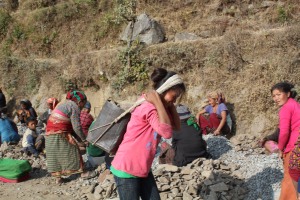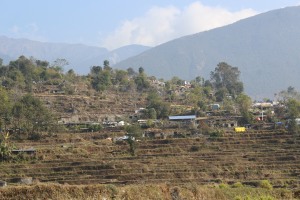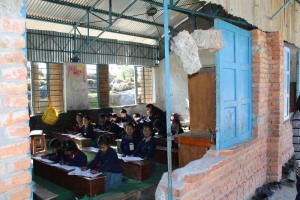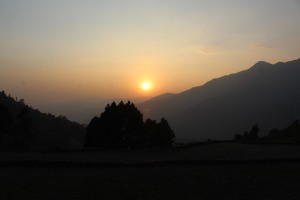In the year 2072 (to us westerners mid-April 2015) a terrible disaster struck Nepal wreaking havoc on an already poor country. Almost 10 months later, most villages are still waiting for the relief money their government is holding.
Thangpalkot is a massive village with 9 wards. I’m going to talk about Thangpalkot 1.
As you may have noticed, I like to make lists!
Facts:
- Thangpalkot is about 2500 meters (7500 feet) above sea level.
- There are over 400 residents.
- Around 20 people died in the earthquakes.
- All the villagers lost their homes, some of which were over 300 years old.
- The villagers lack the money to rebuild and had to use the resources available to them.
- Old homes: cute 2-3 story cottages. The first floor was made of stone and held together with dirt. The 2nd and 3rd layers were wood. With a metal roof.
- Current homes: shacks made from the remains of their condemned houses.
- Current homes offer no protection from the natural elements and little space for large families and storage.
Let’s hit rewind for a minute.
Do you ever have those moments where you know your life is about to change. Some people fight change with everything they have, others embrace it. After all, change or the unknown is scary. I like to think I’m in between leaning towards embracement. Sometimes I embrace change and sometimes I fight it.
Traveling has made me open my eyes to so many things. It’s made me more accepting of change. Why travel if you want everything to stay the same?
Recently, I was having dinner alone. I was absorbed by my books and being extremely antisocial. Then my food came. I put the books away and started openly watching people. I stare a lot more and don’t care as much. I have to thank the Burmese people for that. They are such a curious group and so unashamed that I’ve tried to adopt their practice.
Anyways, there were many people in this restaurant. The normal being groups of 3-4 enjoying drinks and good food. There was one other person dining alone. He was sitting across from me with a table in between us. He was consumed by his headphones, cellphone, and laptop. In case anyone is wondering, the international sign for don’t talk to me is headphones.
I just stared to see if I could catch his eye and I got nothing. It made me sad, 20 years ago people didn’t have technology to distract them. People actually talked to each other. People don’t talk anymore not with apps like Tinder, Facebook, Grinder, you name it. It’s easy to talk to someone online. There is no pressure. It’s scary to talk to someone in person.
I know what you’re thinking. But, Amy, you were reading. Exactly. I knew I was no better than this guy; I had been equally consumed by technology in the form of an ereader. Who’s going to have the guts to approach someone absorbed by technology?
Luckily fate intervened. Spoiler alter!!!! This is not a love story.
After coming back from the toilet, I was laughing at this sign.
The solo diner saw me laughing, we made eye contact, and the rest, as they say, is history. Well, not completely, because I’m going to tell you about it.
We started the normal traveler meets traveler conversation. Where are you from? How long have you been traveling? What are you doing in Nepal?
This guy, Derek Cowan, blew me away with his story. His journey as a solo traveler is to travel to 50 countries and do 50 random acts of kindness (RAK). His first stop is Nepal.
Derek arrived in Nepal in November, made a connection, and was introduced to an amazing guy named Hrinzen. Hrinzen grew up in a remote village. His grandparents still live there, and he talked about the needs of his village. Voilà, Derek has his first RAK (random act of kindness).
Thangpalkot 1 Needs: 86 New HOMES!!!
Grand total of USD 170,000 (GBP 112,000) or about USD 2,000/house.
The villagers still have a hard time believing that Derek is doing this for nothing. Can you imagine? You lose everything. For 9 months you endure; you farm; you live as normally as you can. The pain of losing loved ones and security is always there. You can’t escape it. You are living it. You are constantly reminded by it, because you live in a shack with a nice view of your condemned home. You hope the government will give you money to rebuild.
Then, out of the blue, a westerner walks up and says, “Hey guys, you don’t know me, but I’m going to give you money to rebuild your homes.”
Talk about unbelievable. If that were to happen to me, I’d ask, “What’s the catch?”
To follow Derek’s journey check out http://www.helpthejourney.com
Thangpalkot is by far the most remote I’ve ever been.
Let’s start with getting there. The journey to Thangpalkot was something. Paul and Will (English father/son duo) rented a car and were nice enough to let Derek, Hrinzen, and I catch a ride. We crammed the car as full as we could and were off.
“The roads are rough” is an understatement. Thangpalkot is about 100 km (60 miles) from Kathmandu and it takes SIX, that’s 6 or S-I-X, hours to get there. 6! That is how bad the roads are.
I was hoping to sleep in the car, but boy, was that impossible. Once you’re out of Kathmandu, the “road” is only wide enough to fit 2 cars if they’re going slower than a turtle and in select spots of the “road”. Forget pavement, it’s just holes, sand, and gravel mixed with the occasional dung. We bumped our heads so much, I’m surprises no one got a concussion.
In the monsoon season, it’s nearly impossible to drive to Thangpalkot with roads closing for days, sometimes weeks, at a time. The bridges have been destroyed by the earthquakes and have yet to be rebuilt.
We arrived at the village to an amazing welcome. We (Paul, Will, Derek, and me) were given hot tea, flowers, and a scarf (Buddhist/Hindu custom). We were shown to our tent donated by Canada (Thanks Canada!). The next day, 2 more volunteers arrived (Sander and Lynn, a Dutch couple).
From far away the village is breath taking. It is located on a mountain surrounded by rice terraces and the Himalayas. The earthquake happened over 8 months ago, and the destruction it caused is still evident everywhere you look. The condemned homes are used as storage and the families have built small shacks near by.
There is electricity in the village; thanks to a nearby hydroelectric plant. There is no running water (in the western sense) and no garbage pickup. Oh, and thanks to the Indian/Nepali border problems, there is no gas/petrol for cooking. The locals use local streams for water (they’ve fashioned spouts and use this water for everything from bathing to cooking to watering their crops). They use fires to cook meals. They burn their garbage or just throw it on the ground. They don’t use heaters and the nights are cold.
They eat chicken, goats, and buffalo. Cows, dogs, and oxen are sacred to them.
Random Fun Fact from Jimmy (Parahawking): If you are driving in Nepal, there are 2 things you need to remember. 1. Don’t go too fast. 2. If you have the choice between hitting a child and hitting a cow, run over the child.
The first house is being built, and the locals do all the labor to help keep costs low. The women make gravel (1 of the ingredients for the foundation), and the men are building the homes. The new houses are being built with earthquake resistance in mind. The steel framed structure should take the majority of the impact, and it should be safe in the event of a future earthquake.

I spent my time in the village doing what I could to help. I moved rocks out of the way with the help of some of the young girls.

I tried this…

It was way too painful, the metal edge digs into your back. It’s also heavy. No kidding, it’s filled with rocks. Plus, I was up in higher altitude and struggled for breath with minimal exercise.
I decided to pass on the rock moving, and joined the rock crushing group. I made gravel. The women were so cute. We sat together and gossiped as best we could with the language barrier. I had my station: a rock to sit on, a pile of rocks to crush, a hammer (shaped like a mallet), and a rock catcher (keeps rocks from escaping the mean swing of the hammer. I would also have my keeper: 1 woman would go around and collect the thinner/smaller (aka the easy rocks) for me to break. I still developed blisters. Every time I moved, the women would tell me to take a break. They were so sweet with their concern for my comfort.
I also spent a day and a half at the school. Lynn and I taught classes together. Below, you’ll see, we taught them a game I played in theater. It’s called Bear, rabbit, and elephant.
I loved spending my time with the locals. They really took me in and made me feel I was a part of their families.

I left the village and the first home was nearly complete! In addition, there is already enough money to build 5 more houses!
Update: The first house is compete and the next houses are being built as we speak (or as you read this!). If you are interested in helping out this incredible village, check out www.helpthejourney.com. Please, donate today!































[…] Source: The Year 2072 […]
LikeLike
Reblogged this on charmcity advisor.
LikeLike